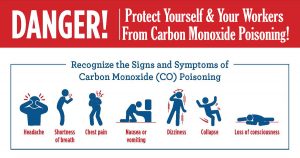6 Ways to Prevent Carbon Monoxide Poisoning Aboard Vessels
 Carbon Monoxide poisoning is often associated with automobiles and homes, but carbon monoxide poisoning can happen in any enclosed or partially enclosed space where fumes and gasses are allowed to accumulate, making fishing boats, tugboats, and other commercial vessels particularly vulnerable if not properly maintained.
Carbon Monoxide poisoning is often associated with automobiles and homes, but carbon monoxide poisoning can happen in any enclosed or partially enclosed space where fumes and gasses are allowed to accumulate, making fishing boats, tugboats, and other commercial vessels particularly vulnerable if not properly maintained.
Carbon monoxide (CO), is an odorless and colorless gas that can poison, cause long term health issues, and even kill a person who inhales too much of it. According to the CDC, approximately 430 people die from accidental CO poisoning in the U.S. each year, and 50,000 people require emergency medical attention due to accidental CO poisoning.
Symptoms of Carbon Monoxide Poisoning
The most common symptoms of carbon monoxide poisoning include headache, dizziness, nausea, weakness, vomiting, and confusion. There are also situations when people pass out before feeling ill effects. It is particularly dangerous to sleep in areas with elevated levels of carbon monoxide, as people have been known to die in their sleep or suffer long term health problems.
According to Dr. Susan Sprau, MD, a hyperbaric medicine specialist and director of the UCLA Gonda Center for Wound Healing and Hyperbaric Medicine, those who are not immediately treated for carbon monoxide poisoning can suffer from chronic and persistent problems with headache, motor weakness, balance issues, vision problems, hearing loss, numbness and tingling in the hands and feet, heart damage, cognitive impairment, and neurological complications such as anxiety and depression.
The UCLA protocol is to first stabilize the patient, then treat with hyperbaric oxygen therapy to saturate the body with oxygen and flush out the toxic CO gas. According to Dr. Sprau, carbon monoxide affixes to the red blood cells in the exact place where oxygen is meant to attach, thus starving the body of oxygen. This causes vascular damage and an inflammatory response within the body.
CO poisoning is entirely preventable. Vessel owners can prevent carbon monoxide poisoning by doing the following:
1) Install CO detectors and change the batteries at least every 6 months, if CO detectors are not hardwired into the vessel. Make sure you use a marine carbon monoxide detector guaranteed by Underwriters’ Laboratories (UL). This device will alert workers if CO levels are detected.
2) Make certain that your vessel is in good repair with no leaks or openings that could allow CO to seep into compartments or areas where people are present. Have your heating systems, water heaters and any other gas, oil, or diesel burning engines serviced by a qualified technician yearly at the very least.
3) Keep vents and flues free of debris. Clogged or blocked exhaust outlets and improperly ventilated enclosures can cause an accumulation of CO in cabins and enclosed areas. Make certain that all exhaust outlets are clean, free of blockages, debris, seaweed, and algae buildup.
4) Keep generators well ventilated. Many larger vessels are equipped with generators that discharge carbon monoxide gas toward the stern. The carbon monoxide that displaces oxygen in an enclosed area can kill a crewmember in a matter of minutes.
5) Anchor or dock your vessel away from other vessels that are running a generator or idling the engine.
6) All crew members should be educated regarding these preventative measures and should understand how to spot carbon monoxide poisoning in crew members.
Under maritime law, a vessel is considered seaworthy only if the vessel, the crew, and all of the equipment are considered reasonably safe to use and perform the assigned tasks and intended purpose. A vessel that retains CO is not considered seaworthy and presents a danger to all crew members. A vessel owner may be held liable for injuries under the Doctrine of Unseaworthiness if the vessel or appliances on it are in any way unseaworthy and caused injuries to a crew member.
 Maritime Injury Law Blog
Maritime Injury Law Blog

